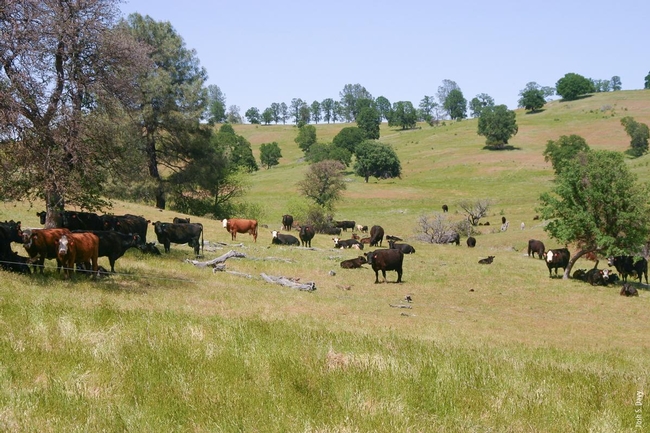UC ANR releases new publication that synthesizes scientific knowledge on annual rangeland
Decades of research-based knowledge about the history, physical characteristics and vegetation in California annual grassland, oak-woodland and chaparral ecosystems has been consolidated in a new nine-part PDF document. The 200-page publication, The Ecology and Management of Annual Rangeland Series, is available for free download from the UC Agriculture and Natural Resources catalog.
The series includes past and current practices for managing vegetation, grazing and livestock compiled by researchers at the University of California, U.S. Department of Agriculture and other agencies and universities.
UC Cooperative Extension rangeland specialist emeritus Mel George, the lead author, said the series has been under development for 10 years. Until his retirement in 2012, George hosted an annual rangeland shortcourse, in which rangeland managers gathered for three days in Davis for presentations, field visits and printed handouts. He collected the materials and created a searchable archive of 700 rangeland publications on the UC Rangeland website, and, with a team of co-authors, summarized the most important information for the new series.
“Information on rangelands doesn't change very fast,” George said. “We have materials that are 20 years old that are still usable; even 100 years old, in a couple of cases.”
The material is broken down in the following categories:
Part 1: Mediterranean climate. The locations and characteristics that define a Mediterranean climate.
Part 2: Ecological history. California has some of the most productive croplands in the world. Recently, increasing conflicts among urban development, intensive agriculture, and protectionism have led to rigid distinctions among resource management objectives. Having a long-term perspective on the causes and interpretation of changes in the landscape can aid in resolving conflicting goals and objectives among stakeholders.
Part 3: Soils. Researchers and managers like to organize the world they live in so that they can explain their environment. This publication presents the soil taxonomy developed by soil scientists to classify soils and understand soil similarities and differences.
Part 4: History of range livestock production. Range livestock production developed as an enterprise with the colonization of California by the Spanish and their formation of ranches or ranchos, and it expanded rapidly during early statehood. The development of improved animal management and range management practices ensured that the industry would continue its dominance in California agriculture throughout the 20th century and into the 21st century.
Part 5: Range plant growth and development. The plants that dominate California's annual grasslands and the understory of the oak woodlands have different life cycles from most of the world's rangelands. This publication delves into morphological and physiological changes associated with annual and perennial life cycles, photosynthesis and carbohydrate storage, and the effect of grazing on individual plants of California's annual-dominated rangelands in the Coast Range and the foothills of the Sierra Nevada.
Part 6: Vegetation change and ecosystem services. Vegetation types in the annual rangelands include annual-dominated non-native grasslands, native-dominated grasslands, oak woodlands, chaparral and coastal scrub. The ecosystem services, or benefits, that humans obtain from each vegetation type change as the vegetation type changes. This section describes the dominant and common species in each vegetation type, the vegetation changes and change agents that are commonly recognized, and an approach to evaluating ecosystem services.
Part 7: Livestock production. Livestock production on California's annual rangelands has adapted to the seasonality of rangeland forage dominated by annual grasses and forbs growing in a Mediterranean-type climate. This part gives an overview of seasonal forage sources, nutrient requirements of grazing animals, seasonal forage quality, seasonal animal performance, supplemental feeding, water needs, livestock production systems and animal health issues.
Part 8: Grazing management. The response of vegetation, livestock and ecosystems to grazing is complex, and grazing managers are confronted with a variety of grazing strategies or systems that are sometimes hard to compare or evaluate. This part covers what are commonly known as the four components of grazing — intensity, season, frequency and duration — and their effects on annual rangelands and provides an overview of the adaptive management process of planning, implementation, and learning that grazing managers can use to help them cope with complexity and knowledge.
Part 9: Vegetation management. An overview of the research and practices for brush and weed control, seeding and fertilization. Also covered are practices that reduce seasonal gaps in forage availability and quality and the economics of vegetation management.
The Ecology and Management of Annual Rangeland Series is at https://anrcatalog.ucanr.edu/Details.aspx?itemNo=8540.



Posted by order food on January 12, 2021 at 3:51 AM